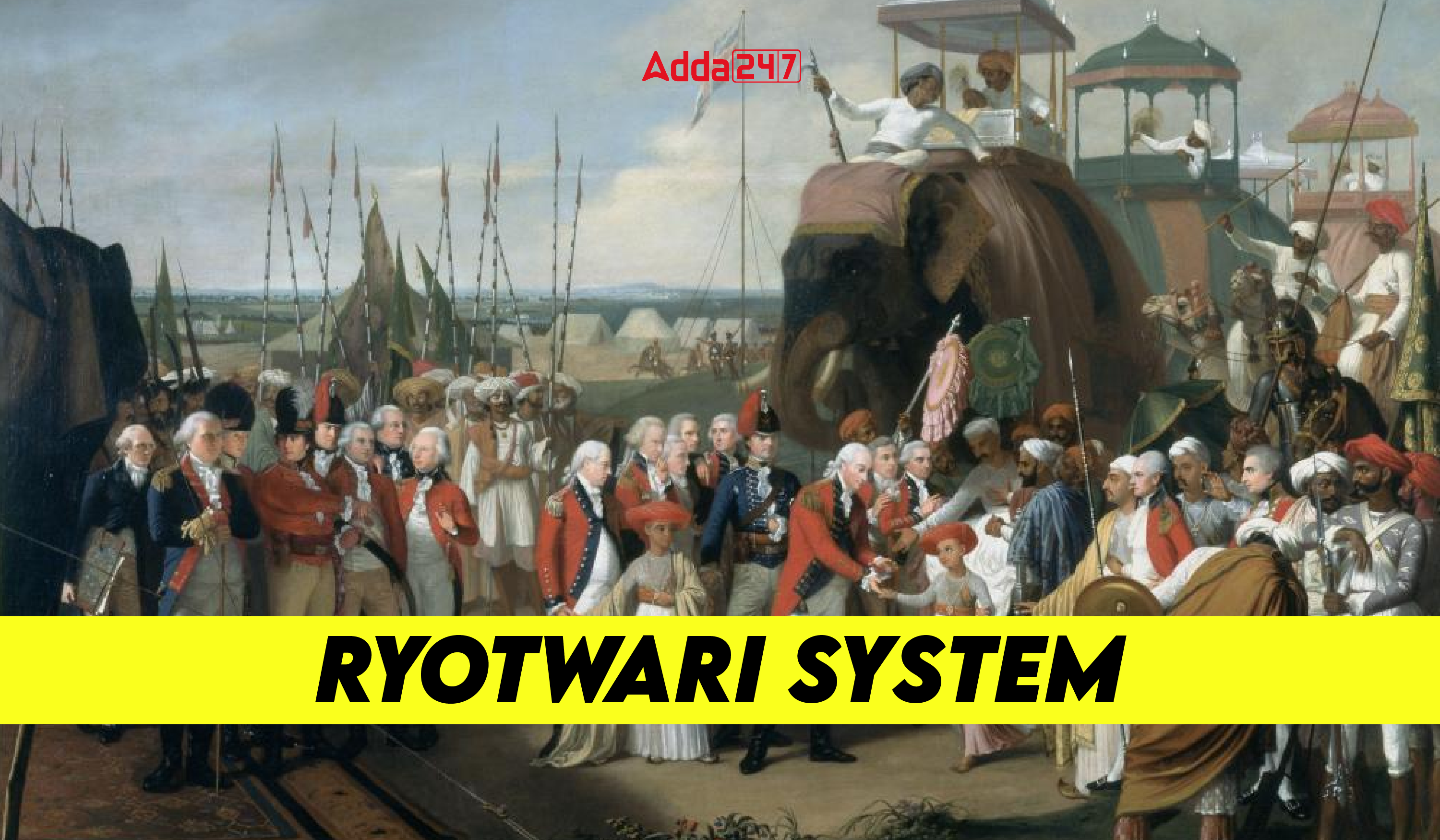Table of Contents
The Ryotwari and Mahalwari Systems, implemented by the British in India, revolutionized land revenue collection. Indian peasants found themselves obligated to surrender a portion of their agricultural yield as taxes. India, renowned for its agriculture and cottage industries, saw a decline in their prominence upon British arrival. The British administration burdened Indians with heavy taxes to fund their governance and military expenditures. This article provide information about the significant of land revenue systems during British rule, highlighting the Ryotwari and Mahalwari systems alongside the well-known Permanent Settlement.
Land Revenue System Before British India
- The Ryotwari and Mahalwari Systems, though introduced later, emerged from an ancient tradition of land revenue collection.
- Land revenue constituted a significant income source for kings throughout history.
- Jagirs were common divisions of land, allocated to Jagirdars by the ruling authority.
- Jagirdars, in turn, subdivided these lands and assigned them to Zamindars.
- Zamindars bore the responsibility of collecting land revenue from peasants, often in the form of agricultural produce.
- The Mughal era saw the prevalence of their distinct land revenue system, comprising Ghalla Bakshi, Kankut, and Zabti Systems.
Land Revenue System
Land revenue systems have been around for centuries, as a way for governments to collect taxes from land use. But the one you might be interested in is likely the Land Revenue System in British India. This system was a major source of income for the British Raj. There were three main types of Land Revenue Systems implemented in British India:
- Zamindari System: This permanent settlement system, introduced in Bengal and parts of Bihar and Orissa, recognized Zamindars as the permanent owners of the land. Zamindars collected rent from peasants and kept a portion for themselves, while remitting the rest to the British East India Company. While this provided a stable income stream for the British, it sometimes led to exploitation of peasants by Zamindars.
- Ryotwari System: Introduced by Thomas Munro in Madras and Bombay presidencies, this system dealt directly with the peasants (ryots) as landowners. Revenue was assessed based on land quality and crop yield. While this aimed for a fairer system, the revenue demands could be high, putting a burden on peasants.
- Mahalwari System: Implemented in North-Western Provinces and Central India, this system recognized the village community (Mahal) as the revenue unit. The village headman was responsible for collecting revenue from individual farmers. This system aimed to leverage community responsibility for tax collection.
These Land Revenue Systems had a significant impact on Indian society and agriculture. They contributed to increased commercialization of agriculture but also led to inequalities and famines. Understanding these systems is important for comprehending Indian history and the development of land rights in the country.
Zamindari System
The Zamindari System, implemented in British India, was a land revenue system that relied on intermediaries known as Zamindars to collect taxes from peasants. Introduced by Lord Cornwallis in 1793 through the Permanent Settlement Act, it became the dominant system in Bengal, Bihar, Orissa, parts of Uttar Pradesh, Madhya Pradesh, and Andhra Pradesh. Read here about how the Zamindari System functioned:
- Intermediary Revenue Collection: The British East India Company, and later the British Raj, appointed Zamindars, who were traditionally tax collectors or wealthy landowners, to oversee revenue collection. Zamindars were given the right to collect rents from peasants cultivating the land within their zamindari (estate).
- Fixed Revenue Demand: A key feature of the Permanent Settlement Act was fixing the land revenue amount that Zamindars had to pay the British government in perpetuity. This aimed to create a stable source of income for the British, but it also meant the revenue burden wouldn’t adjust to changing economic conditions.
- Zamindari Profits: Zamindars were entitled to keep a portion of the rent collected from peasants as their profit. In theory, this incentivized them to manage their estates efficiently. However, this also opened the door to exploitation.
Impact of the Zamindari System: The Zamindari System had significant positive and negative consequences for India:
- Positives:
-Provided a seemingly stable and predictable revenue stream for the British.
-Theoretically offered Zamindars an incentive to improve land productivity. - Negatives:
-Zamindars often prioritized maximizing their profits by raising rents on peasants, leading to exploitation and poverty.
-Peasants had no security of tenure and could be evicted if they couldn’t pay rent.
-The system discouraged investment in land improvement as increased productivity wouldn’t benefit peasants.
-Limited revenue flexibility for the British government as the fixed rates couldn’t be raised.
The Zamindari System’s emphasis on fixed revenue for the British and profit maximization for Zamindars came at the cost of the peasants’ well-being. This system is considered a major factor contributing to rural poverty and famines in British India. The Zamindari System was eventually abolished in independent India through various land reform acts.
Ryotwari system
The Ryotwari system, implemented in British India, was a land revenue system designed to collect taxes directly from peasants, known as ryots. Introduced by Sir Thomas Munro in the late 18th century, it was primarily used in the Madras and Bombay Presidencies, as well as Assam and Coorg. Read more about the Ryotwari System below:
- Direct Interaction: Unlike the Zamindari system, the Ryotwari system bypassed intermediaries. The government directly assessed and collected taxes from individual ryots.
- Proprietary Rights: In theory, ryots were recognized as holders of land rights. They could sell, inherit, or lease their land. However, some argue these rights were limited by the high taxes.
- Tax Assessment: Revenue assessment was based on land quality, type of crop grown, and the area under cultivation. This aimed for a fairer system compared to a flat tax.
- Tax Rates: The tax rates, however, were a point of contention. They could be as high as 50% for dry land and 60% for wet land, placing a significant burden on cultivators. There were provisions for adjustments during droughts or famines, but these weren’t always implemented effectively.
Impact of the Ryotwari System: The Ryotwari system had both positive and negative consequences:
- Positives:
-Eliminated exploitative intermediaries like Zamindars.
-Theoretically offered land ownership rights to peasants.
-Encouraged investment in land improvement by ryots.
- Negatives:
-High tax rates could lead to indebtedness and land loss for ryots.
-Power imbalance between revenue officials and cultivators.
-Less emphasis on community-based land management.
The Ryotwari system, while aiming for a more direct and potentially fairer approach to tax collection, had its limitations. The high tax burden and limited support for ryots during hardships contributed to vulnerabilities for Indian peasants under British rule.
Mahalwari system
The Mahalwari system, implemented in British India, functioned quite differently from the Ryotwari system. Introduced in 1822 by Holt Mackenzie in the North-Western Provinces and Central India, it aimed to collect land revenue through village communities rather than individual farmers. Read more about the Mahalwari system below:
- Community Focus: Unlike the Ryotwari system’s individual approach, the Mahalwari system treated the village (Mahal) as the unit of revenue assessment. This leveraged the traditional village structure and collective responsibility.
- Village Leadership: The village headman, or Lambardar, played a crucial role. They were responsible for assessing land within the village, collecting taxes from individual farmers, and remitting the total sum to the British authorities.
- Land Ownership: Similar to the Ryotwari system, peasants (cultivators) were recognized as holders of land rights. They could sell, inherit, or mortgage their land.
- Revenue Assessment: Revenue was assessed based on the overall productivity of the entire Mahal, considering factors like land quality and crop yield. Individual shares within the village were then determined.
- Shifting Responsibility: A key difference from the Ryotwari system was that the British government held the village community, as a whole, accountable for tax collection. This could lead to internal pressure within the village to ensure everyone contributed their share.
Impact of the Mahalwari System: The Mahalwari system had its own set of advantages and disadvantages:
- Positives:
-Preserved some degree of village autonomy and self-governance.
-Potentially fostered a sense of collective responsibility within the village.
-Provided some flexibility in tax assessment based on overall village productivity. - Negatives:
-Village headman could become too powerful and exploit fellow villagers.
-Collective responsibility could burden poorer peasants within the Mahal.
-Limited incentive for individual farmers to improve their land.
The Mahalwari system attempted to balance the need for revenue collection with the existing social structure of villages in British India. However, it wasn’t without its drawbacks. The power dynamics within villages and the potential for exploitation by headmen were significant concerns.
Consequences of British Land Revenue System
Candidates can read here about comparison between the Zamindari, Ryotwari, and Mahalwari System:
| Zamindari System | Ryotwari System |
Mahalwari System
|
| The Zamindari System was introduced by Lord Cornwallis in 1793. | The Ryotwari System was introduced by Thomas Munro in 1820. |
The Mahalwari System was devised by Holt Mackenzie in 1822 and introduced in India by Lord William Benthick in 1833.
|
| The land revenue was collected by the intermediaries known as Zamindars from the peasants. | The land revenue was paid directly by the peasants. |
The land revenue was collected by the village headman from all the peasants in that village.
|
| Zamindars were made the owners of the land. | Peasants had the ownership over the land. |
Peasants had the ownership over the land.
|
| The revenue to be collected was fixed permanently. | The revenue to be collected was revised periodically. |
The revenue to be collected was revised periodically.
|
| This system was prevalent in the provinces of Bengal, Orissa, Bihar and Varanasi | This system was prevalent in Madras, Bombay and in some part of Assam and Coorg |
This system was prevalent in the North west frontier province, Punjab, Gangetic valley and central province
|
In addition to the Ryotwari, Mahalwari, and Zamindari Systems, the British also implemented the Talukdari and Malguzari Systems. This illustrates the heavy taxation burden imposed by the British on the native population to sustain their administration. Consequently, British land revenue policies transformed land into a commodity, leading to the emergence of a class of bonded laborers. Tied to their land indefinitely, peasants faced considerable hardships in meeting their basic needs under these British-imposed land revenue systems.



 TSPSC Group 1 Question Paper 2024, Downl...
TSPSC Group 1 Question Paper 2024, Downl...
 TSPSC Group 1 Answer key 2024 Out, Downl...
TSPSC Group 1 Answer key 2024 Out, Downl...
 UPSC Prelims 2024 Question Paper, Downlo...
UPSC Prelims 2024 Question Paper, Downlo...





